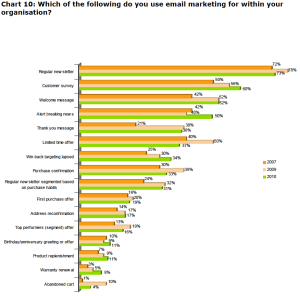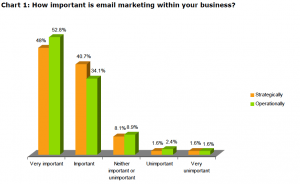2010 DMA National Client Email Marketing Report
Value: [rating=4]
Our commentary : I recently wrote the conclusion for the 2010 Annual Client Email report for the UK Direct Marketing Association.
Here I share what I took from the report and highlight some of the key findings through charts (click twice to read) which show the importance of email marketing and the most popular techniques. You can see that despite some of the mispronouncements that Email Marketing is Dead, Email is a key part of communications strategy for many organisations but given the competition in the inbox from rise of social media and prioritised inboxes it needs to evolve to continue to cut-through.
Marketing implications :
For me, the rate of innovation within digital marketing is one of its greatest appeals. Whether it"€™s the introduction of new technologies, marketing approaches or resulting changes in consumer behaviour, change is a constant challenge. The annual UK DMA National Client Email Marketing Report provides marketers with a valuable resource to share the latest challenges and opportunities from Email communications.
The 2010 report shows that email marketing remains of great strategic importance to most organisations surveyed despite many attention-grabbing claims that social media heralds the "€œdeath of email"€. Social media has certainly garnered more coverage in the marketing trade press and blogs, but I believe this reflects the appeal of the novelty of social media rather than a decline in the effectiveness of email marketing.
Most organisations surveyed here are planning to increase budget on email marketing, with over 90% believing it to be important or very important to their business, perhaps reflecting the sample.
So what then are the new challenges and opportunities from email marketing in 2010? I think most email marketers would agree that social media is both a major challenge and an opportunity. Certainly it has increased inbox competition with this report noting that 15-20% of email received at Hotmail is social media notifications. But it has increased the opportunity to engage customers through email through integrated campaigns engaging through the interactivity, reviews and promotions that social media channels offer.

The opportunities of integrating email with social media make an even stronger case for a coherent contact strategy. Not simply an email contact strategy, but an integrated multichannel communications strategy incorporating email, social media participation and traditional channels. This report suggests many organisations still need to give this more attention. The report suggests an increase in email frequency while around half of company don"€™t have a maximum contacts policy. I was also surprised that the number of companies using targeted, event-triggered emails also appears to have fallen. This is surely one of the most powerful benefits of email marketing.
I was less surprised to see that deliverability remains the most significant concern for email marketing and a key criteria for selecting email service providers. Maintaining and improving open and click rates were not far behind as perceived challenges and Mark Brownlow rightly highlights the problem of the "€œemotionally unsubscribed"€ and the inability of many companies to track "€œbeyond the click"€ to purchase or other outcome.
Traditional concerns of budget, resource and data integration remain high suggesting that insufficient budget is available to tackle the development of more refined targeting and triggered communications strategies. If email marketing is to continue to demonstrate its value, projects to refine these will be required by those who haven"€™t tackled the problem of the emotionally unsubscribed.
Recommended link: Email Benchmarking Review








